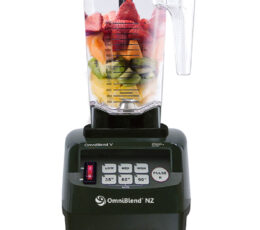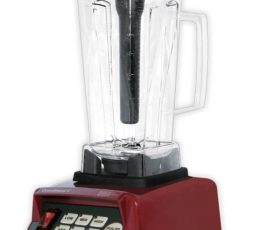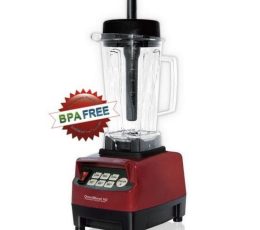By definition a blender is an electric machine that helps to liquidise, puree, mix or chop food. It reduces effort and saves you time. If you are after a blender especially for making smoothies and frozen drinks, you need a powerful one. The Omniblend has been built with commerical-grade construction which means it is a high-powered blender and can blend soup, process foods, make nut milks, smoothie bowls, sauces, dips and a multitude of other food products.
Here are our top six things you should look out for when buying a blender.
THE JAR
The least expensive blender containers are made from plastic. The advantages of plastic are that it’s lightweight and chip-proof. However plastic blender jars bring with them risks of chemical leaching and are scratch-prone.
Glass jars are sturdier and you can see the ingredients in them better than plastic. Glass is durable and won’t discolour or absorb odours from food the way plastic can. They are also easier to clean. However, they are also heavy, and can break and chip more easily. Few (if any) manufacturers) produce glass blender jars.
The Omniblend jar is made from Eastman-Tritan BPA-free co-polyester, certified food-safe so you can be sure that it is safe for you and your family. It’s extremely strong. as we have shown here (VIDEO). The OmniBlend has three jar options:

- 2L “Pro jar” Highest capacity, best-performance (but a bit trickier to clean)
- 1.5L standard jar. Good capacity, easy to clean.
- 1.5L B-jar. Combines the best of the 2L (narrow base) and 1.5L (straight sides and easy fitting lid). Also comes in colour options – Plain, yellow or green: ideal for cafes needing to prevent allergen contamination.
DRIVE SOCKET AND BLADES
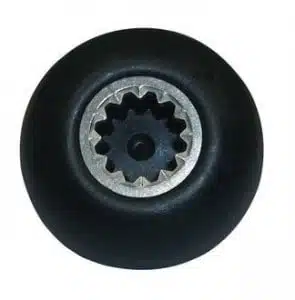
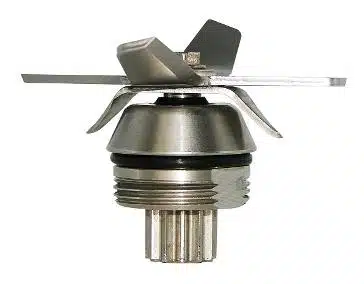
POWER USAGE
If you’re thinking energy-efficiency, knowing the wattage usage of the blender is very important:
- 300 watts: Blenders with 300-watts power output are fine for chopping and blending softer ingredients like bananas and oranges effectively. But they are not good at blending harder foods like nuts or carrots.
- 500 to 700 watts: A blender rated at 500 to 700-watts is probably adequate for making smoothies and soups. It’s one step up from a 300-watt machine.
- Over 700 watts: Anything above 700 watts has even greater blending capacity for harder ingredients. If you want to blend items by breaking them into tiny grains and fine grounds, using a blender that offers 700-watts or more power is suitable.
SPEED
Being able to start a blender at a slow speed and gradually increase it to high reduces stress on the motor. High-performance blenders like the Omniblend offer pre-programmed speed settings or fully manual operations. This helps quicken the speeding process and allows you to control consistency based on what you’d like. Not all blenders offer this.
The Omniblend V has 3 Speeds (Low, Medium, High). Medium starts on LOW and moves automatically up to Medium within about 2 or 3 seconds after depressing the soft touch key button. High starts also on LOW and moves to MEDIUM, and then to HIGH in about 3 to 4 seconds time. This automatic speed increase is designed to give you more power blending up ingredients. During the brief 2 second stop the top of the ingredients go back down towards the blade. When the blender during its blending cycle starts up again, it then begins at LOW, goes to MEDIUM, and then to HIGH. Pressing any button during auto-function stops the cycle. The Omniblend I is fully manual – you dial up the speed from slow to the maximum desired.
FUNCTIONS
If you plan to make nut butters, iced drinks or sorbets, a “pulse” button is what you need. Without the pulse button on a blender, you would have to stop and mix up the ice before starting the motor again, or risk things overheating. The Pulse feature on the Omniblend will operate on it’s highest speed as long as the Pulse button is held. The pulse feature will help blend ice cubes into snow. The electronic functions of the Omniblend V includes pre-programmed cycles that switch off when they’re done.


CLEANING
Who is in love with cleaning up?? Fortunately to clean the Omniblend is a simple matter. First rinse out any food residue, then just but warm water and a drop (not more than two!) in the jar and blitz it on HIGH for 10-15 seconds. Rinse with clear water and leave to dry. Easy-as!

